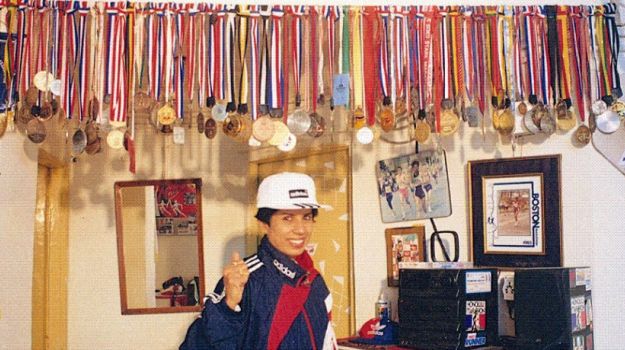
Students of pole fitness nearly always bring up their bruises. Evidence of pole chafing—crimson and blue orbs found on calves, underarms and palms—is generally displayed with pride, and a permissible degree of smugness. It is a badge of honour, a testimony of their endurance.
At Aarifa Bhinderwala’s pole fitness class, Pole Burnt, women in polka-dotted bodysuits and bottom-clinging boy shorts perform choreographed floor squats to warm up. The playlist is soft and soulful, drifting from Leonard Cohen’s Dance Me To The End Of Love to Coldplay’sYellow, before giving in to a bit of Bollywood nostalgia. Baadalon Mein Chhup Raha Hai Chand Kyun, an offbeat inclusion chiming perfectly with gentle “Peter Pan” swings.
These weekend sessions, held at Mumbai’s new boutique fitness studio The Space, fuel an uninhibited feminine energy that is both powerful and graceful. The mood is one of generous camaraderie. Students pair up to bolster each other through tricky inversions, cheer breakthroughs and swap sartorial inspiration.
It takes actual doing to appreciate the sheer strength required for pole workouts. On a late Saturday afternoon, I joined 10 other women at the large, minimally lit studio for my first attempt. While I ungracefully slid down my pole, the advanced student next to me casually climbed up hers—propelled entirely by arm strength—until her head brushed against the ceiling; another student perfected “The Chopper”, an inversion where your legs rest over your head in an open V. Once she had settled in this position, Bhinderwala walked over and gently turned her towards the mirror. “Look at yourself!” she exclaimed.
For many students, the payback, apart from a stronger core and increased upper-body strength, is the thrill of watching a new version of themselves. Niharika Arora, a 23-year-old architecture student, signed up for Bhinderwala’s class to shatter a restrictive self-image and a prolonged spell of inertia. “Initially, I thought it was too ‘out there’ for someone like me, and I’d just make a fool of myself. But pole fitness is like flying—it’s exhilarating. And let’s face it, everyone wants to be superwoman,” she says.

Getting into the swing of things
Bhinderwala says an agile body is an asset, but not a prerequisite. As someone who mistook good metabolism for a sign of good health, I now contend with tight hamstrings and a feeble core, but, at the end of my first class, I managed to stay off-ground for several elementary-level spins. “It’s a common misconception that you have to be fit to do pole, that’s not true. You do pole to get fit,” says Bhinderwala. Essential notes to remember for your first pole class: Wear minimum fabric—this has to do with technique, not aesthetics, as skin contact is essential for a firm grip; don’t apply any cream or moisturizer before the class; and carry a hand towel to wipe your pole. Expect some lingering upper-body aches (these will lessen as you gain strength), and, depending on how enthusiastically you engage with the pole, some sores and bruises.
“I’m at a point in my life where I need something to give me confidence and make me feel better about myself,” says Pallavi Punvani, a 31-year-old MBA graduate who has moved recently from New York to Mumbai. “I was talking to my parents about taking a pole class, and they asked me what the point of it was. Where are you going to do this? I said, maybe I’ll just get a pole at home.”
Portable poles help students stay connected with the sport outside of class and are easy to install and use, even in cramped Mumbai apartments. But since no reliable local retailers exist, Bhinderwala recommends getting them from international retailers.
One of the first trainers to introduce pole in Mumbai was Shilpa Rane, who now holds weekly classes at her Dadar studio. Rane attended a pole workshop in London in 2002, and, a few years later, decided to include it in her fitness programme to entice students who felt dulled by monotonous routines. She also designed an “exotic dance workout”, with elaborate costumes (think feather boas and sharp stilettos), suggestive choreography and pillars standing in as poles—she continues to hold that class today, in addition to the more strenuous pole fitness sessions she began in 2010, when she finally had access to a private studio and stainless-steel poles.
For these early adaptors, pole dancing held a forbidden thrill. A colleague at Mint, a reporter who attended one of these classes, confirms a coy, discreet, giggly atmosphere. “Many of them were well-travelled, open-minded women, but they wouldn’t even tell close friends that they were coming for this class. I’d say some of that stigma still exists today,” says Rane. “I wanted to create a safe space where all kinds of women could feel sexy, with no judgement. There’s such a homogenization of beauty nowadays that we all end up looking and acting alike.”
It was Bhinderwala’s students who embraced the pole without caution and anonymity. In 2016, she had just completed her advanced training in Perth, and returned to set up a modest four-pole class at her home in Mumbai. Later that year, a video produced by the women-focused YouTube channel Blush featured a short profile of her. In black shorts and a sports bra, she performed acrobatic swings and inversions, and spoke uninhibitedly about how, despite being a Bohri Muslim woman with a sister who wears the hijab, she didn’t have to fight any domestic wars to pursue her passion for pole dance. Her mother, raising two daughters with different predilections but equal freedoms, also made a short appearance to say, “If we are going to talk about women empowerment, first let’s liberate ourselves, our families.”
The video went viral, and enquiries starting trickling in. A year later, Bhinderwala has taught more than 400 students, between the ages of 7 and 50.

#Girlswhopole and instagram bragging rights
On social media, pole manoeuvres are widely shared and hashtagged. If you live in Mumbai, it’s likely that at least one such video of a friend, or friend-of-friend, has surfaced on your feed. “Yeah, my friends are constantly ’gramming moments from the class; it’s actually where most enquires come from,” laughs Bhinderwala (her own handle, @aarifa.pole.burnt, is a reliable source of “fitspiration”). Each session throws up spectacular photo ops, and Bhinderwala happily rushes forward with her phone to oblige a student with a composition or video. But the interest, she says, goes far beyond Instagram bragging rights.
“The demand is massive—it’s overwhelming—but so is the level of commitment. I teach an MBBS student who comes to the door buried in her textbook, puts it down, finishes pole class, and goes right back to her textbook. I have two students who travel from Pune every weekend for a 1-hour class and drive back.”
Feeding this energetic response is the country’s most effective influencer: Bollywood. Possibly the only reason to recall the 2017 movie A Gentleman is to credit its role in legitimizing pole fitness. In the song Chandralekha, actor Jacqueline Fernandez breaks into a deft pole routine, for which she was trained by Ukrainian fitness trainer Roksolana Chubenko. Since the release of the film, Mumbai-based Chubenko, who offers private lessons at her studio, has witnessed a sharp increase in enquires, including from men. “Body builders, dancers, athletes have been expressing a professional interest but for now, only (actor) Varun Dhawan has gone beyond an enquiry and actually taken a couple of classes with Jacqueline. He is very fit and it was a lot of fun to work out with him,” she says on email.
Bhinderwala acknowledges the interest from men, but the numbers don’t yet merit regular classes. Ironically, in the East, the origin of pole fitness goes back to two traditionally boys-only vertical apparatus sports: Chinese pole, in which male acrobats performed physical feats on rubber poles 10-30ft tall, and the ancient Indian sport of mallakhamb, which translates to “pole athlete” or “pole wrestler”. In the West, the pole found relevance as hyper-sexualized nightclub entertainment, until former Canadian stripper Fawnia Mondey, credited as the pioneer of contemporary pole fitness, finally mined the activity for its physical benefits. It was her idea to design pole lessons for other women—she set up a studio in 1994 and later released the first instructional video.

While talking to students and instructors in the city, I found that pole fitness and pole dance are often used interchangeably, though they differ by a few shades, the difference varying from one instructor to another. Pole workouts can be loosely categorized into three forms—pole dance, where sensuality and choreography are in focus; pole fitness, which prioritizes strength and endurance; and artistic pole, usually undertaken by gymnasts and performed at a competitive level. “I prefer to just call it ‘pole’ because that’s what I learnt in Australia,” says Bhinderwala. “I think the art and the sport are intertwined, you can’t separate the two.”
At present, a shortage of certified instructors and training centres makes pole fitness a Mumbai-centred workout. Delhi-based holistic fitness expert Vesna Jacob, a rare pole fitness practitioner outside the financial capital, uses vertical apparatus workouts as an add-on to Pilates sessions, but a spike in demand has prompted her to schedule group classes from next month. Jacob says pole fitness is in line with the current wave of feminism, which is both outspoken and defiant.
“Pole fitness is a way of being a little rebellious, a little naughty,” says Jacob. “It is a fact that pole dancing and striptease have been used in places where women were objectified. But it is also a fact that female sexuality has been deeply repressed for centuries. We’ve been made to feel like it’s something dirty, and we shouldn’t express ourselves sexually. We should neither be ashamed nor confused about (wanting to feel sensual). My classes will work on purifying, reclaiming and liberating that aspect of ourselves.”
Internationally, pole dancing has earned a new respectability as well. Last October, it was officially recognized as a sport by the Global Association of International Sports Federation, the result of an 11-year campaign by British competitor Katie Coates, and might be on its way to becoming an Olympic sport. Once it’s rid of its oppressive baggage, the image of a minimally clad woman spinning around a pole could soon signal an empowered and formidable sportswoman.
[“Source-livemint”]










